Individual Organizational Problem Analysis Assessment 1: ACU 2017
VerifiedAdded on 2020/02/19
|13
|2782
|31
Annotated Bibliography
AI Summary
This annotated bibliography, prepared for an Australian Catholic University assessment in 2017, examines various organizational problems through the lens of five scholarly articles. The bibliography explores key concepts such as knowledge sharing, organizational behavior, the impact of organizational culture on efficiency, the management of organizational change, and the relationship between organizational culture, leadership behavior, and job satisfaction. The articles delve into topics including organizational analysis methods, the influence of individual and group behavior on organizational outcomes, the effects of leadership and culture, and the dynamic processes that affect organizations. The analysis highlights the interconnectedness of these elements and their collective influence on organizational performance and employee well-being. The conclusion emphasizes the value of annotated bibliographies in providing a comprehensive overview of complex topics and their relevance to organizational challenges.
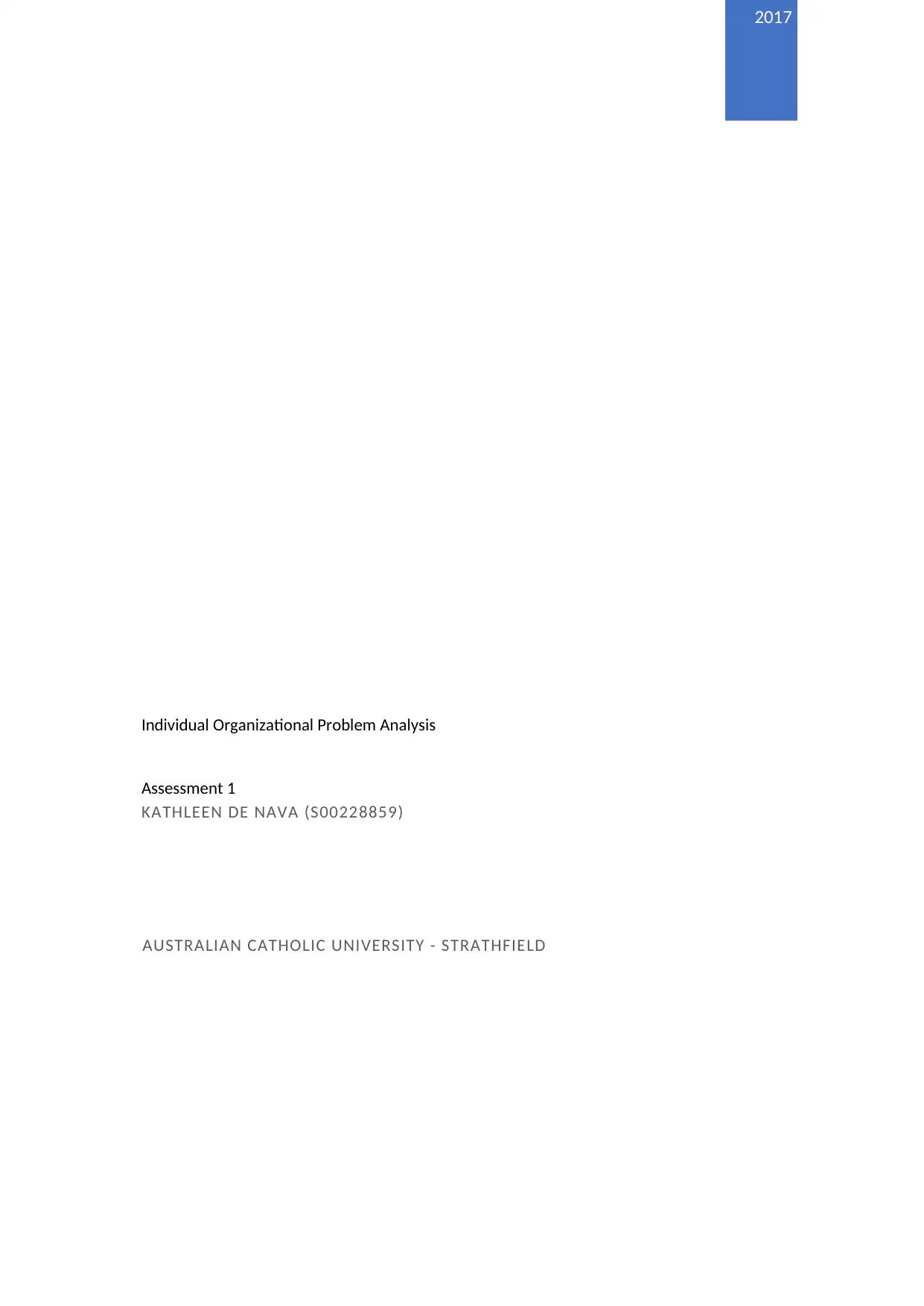
2017
Individual Organizational Problem Analysis
Assessment 1
KATHLEEN DE NAVA (S00228859)
AUSTRALIAN CATHOLIC UNIVERSITY - STRATHFIELD
Individual Organizational Problem Analysis
Assessment 1
KATHLEEN DE NAVA (S00228859)
AUSTRALIAN CATHOLIC UNIVERSITY - STRATHFIELD
Paraphrase This Document
Need a fresh take? Get an instant paraphrase of this document with our AI Paraphraser
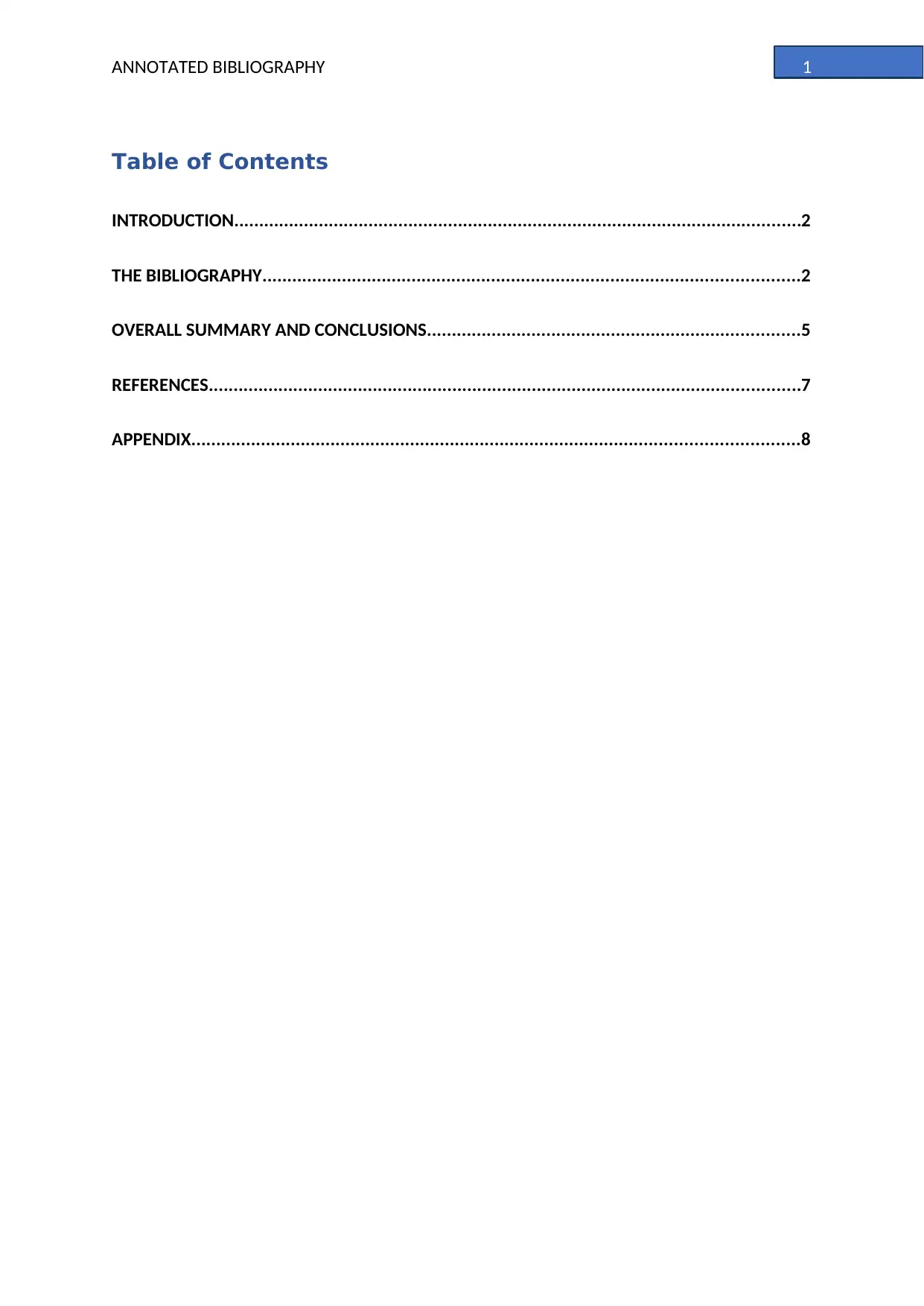
ANNOTATED BIBLIOGRAPHY
Table of Contents
INTRODUCTION..................................................................................................................2
THE BIBLIOGRAPHY............................................................................................................2
OVERALL SUMMARY AND CONCLUSIONS...........................................................................5
REFERENCES.......................................................................................................................7
APPENDIX..........................................................................................................................8
1
Table of Contents
INTRODUCTION..................................................................................................................2
THE BIBLIOGRAPHY............................................................................................................2
OVERALL SUMMARY AND CONCLUSIONS...........................................................................5
REFERENCES.......................................................................................................................7
APPENDIX..........................................................................................................................8
1
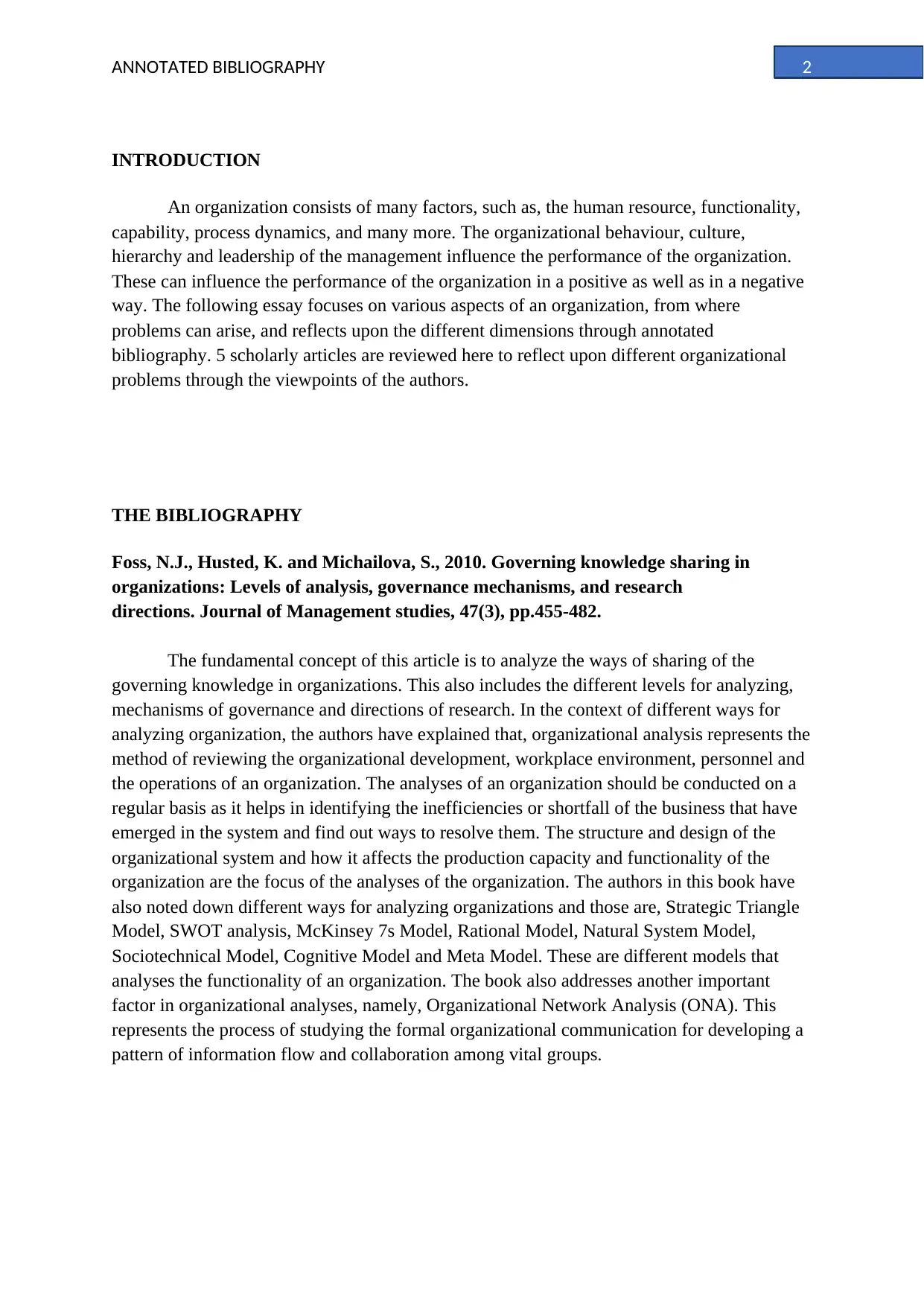
ANNOTATED BIBLIOGRAPHY
INTRODUCTION
An organization consists of many factors, such as, the human resource, functionality,
capability, process dynamics, and many more. The organizational behaviour, culture,
hierarchy and leadership of the management influence the performance of the organization.
These can influence the performance of the organization in a positive as well as in a negative
way. The following essay focuses on various aspects of an organization, from where
problems can arise, and reflects upon the different dimensions through annotated
bibliography. 5 scholarly articles are reviewed here to reflect upon different organizational
problems through the viewpoints of the authors.
THE BIBLIOGRAPHY
Foss, N.J., Husted, K. and Michailova, S., 2010. Governing knowledge sharing in
organizations: Levels of analysis, governance mechanisms, and research
directions. Journal of Management studies, 47(3), pp.455-482.
The fundamental concept of this article is to analyze the ways of sharing of the
governing knowledge in organizations. This also includes the different levels for analyzing,
mechanisms of governance and directions of research. In the context of different ways for
analyzing organization, the authors have explained that, organizational analysis represents the
method of reviewing the organizational development, workplace environment, personnel and
the operations of an organization. The analyses of an organization should be conducted on a
regular basis as it helps in identifying the inefficiencies or shortfall of the business that have
emerged in the system and find out ways to resolve them. The structure and design of the
organizational system and how it affects the production capacity and functionality of the
organization are the focus of the analyses of the organization. The authors in this book have
also noted down different ways for analyzing organizations and those are, Strategic Triangle
Model, SWOT analysis, McKinsey 7s Model, Rational Model, Natural System Model,
Sociotechnical Model, Cognitive Model and Meta Model. These are different models that
analyses the functionality of an organization. The book also addresses another important
factor in organizational analyses, namely, Organizational Network Analysis (ONA). This
represents the process of studying the formal organizational communication for developing a
pattern of information flow and collaboration among vital groups.
2
INTRODUCTION
An organization consists of many factors, such as, the human resource, functionality,
capability, process dynamics, and many more. The organizational behaviour, culture,
hierarchy and leadership of the management influence the performance of the organization.
These can influence the performance of the organization in a positive as well as in a negative
way. The following essay focuses on various aspects of an organization, from where
problems can arise, and reflects upon the different dimensions through annotated
bibliography. 5 scholarly articles are reviewed here to reflect upon different organizational
problems through the viewpoints of the authors.
THE BIBLIOGRAPHY
Foss, N.J., Husted, K. and Michailova, S., 2010. Governing knowledge sharing in
organizations: Levels of analysis, governance mechanisms, and research
directions. Journal of Management studies, 47(3), pp.455-482.
The fundamental concept of this article is to analyze the ways of sharing of the
governing knowledge in organizations. This also includes the different levels for analyzing,
mechanisms of governance and directions of research. In the context of different ways for
analyzing organization, the authors have explained that, organizational analysis represents the
method of reviewing the organizational development, workplace environment, personnel and
the operations of an organization. The analyses of an organization should be conducted on a
regular basis as it helps in identifying the inefficiencies or shortfall of the business that have
emerged in the system and find out ways to resolve them. The structure and design of the
organizational system and how it affects the production capacity and functionality of the
organization are the focus of the analyses of the organization. The authors in this book have
also noted down different ways for analyzing organizations and those are, Strategic Triangle
Model, SWOT analysis, McKinsey 7s Model, Rational Model, Natural System Model,
Sociotechnical Model, Cognitive Model and Meta Model. These are different models that
analyses the functionality of an organization. The book also addresses another important
factor in organizational analyses, namely, Organizational Network Analysis (ONA). This
represents the process of studying the formal organizational communication for developing a
pattern of information flow and collaboration among vital groups.
2
⊘ This is a preview!⊘
Do you want full access?
Subscribe today to unlock all pages.

Trusted by 1+ million students worldwide
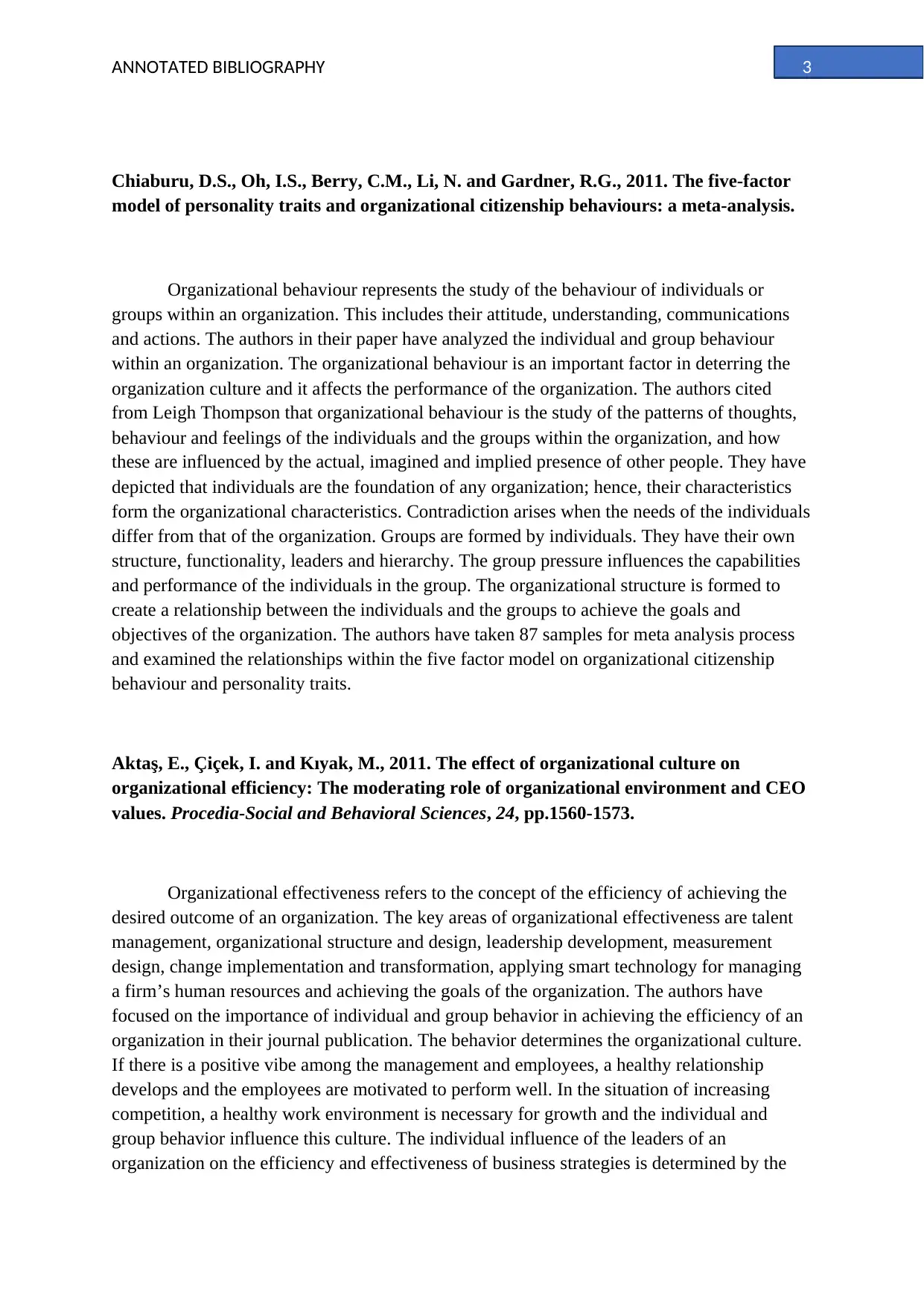
ANNOTATED BIBLIOGRAPHY
Chiaburu, D.S., Oh, I.S., Berry, C.M., Li, N. and Gardner, R.G., 2011. The five-factor
model of personality traits and organizational citizenship behaviours: a meta-analysis.
Organizational behaviour represents the study of the behaviour of individuals or
groups within an organization. This includes their attitude, understanding, communications
and actions. The authors in their paper have analyzed the individual and group behaviour
within an organization. The organizational behaviour is an important factor in deterring the
organization culture and it affects the performance of the organization. The authors cited
from Leigh Thompson that organizational behaviour is the study of the patterns of thoughts,
behaviour and feelings of the individuals and the groups within the organization, and how
these are influenced by the actual, imagined and implied presence of other people. They have
depicted that individuals are the foundation of any organization; hence, their characteristics
form the organizational characteristics. Contradiction arises when the needs of the individuals
differ from that of the organization. Groups are formed by individuals. They have their own
structure, functionality, leaders and hierarchy. The group pressure influences the capabilities
and performance of the individuals in the group. The organizational structure is formed to
create a relationship between the individuals and the groups to achieve the goals and
objectives of the organization. The authors have taken 87 samples for meta analysis process
and examined the relationships within the five factor model on organizational citizenship
behaviour and personality traits.
Aktaş, E., Çiçek, I. and Kıyak, M., 2011. The effect of organizational culture on
organizational efficiency: The moderating role of organizational environment and CEO
values. Procedia-Social and Behavioral Sciences, 24, pp.1560-1573.
Organizational effectiveness refers to the concept of the efficiency of achieving the
desired outcome of an organization. The key areas of organizational effectiveness are talent
management, organizational structure and design, leadership development, measurement
design, change implementation and transformation, applying smart technology for managing
a firm’s human resources and achieving the goals of the organization. The authors have
focused on the importance of individual and group behavior in achieving the efficiency of an
organization in their journal publication. The behavior determines the organizational culture.
If there is a positive vibe among the management and employees, a healthy relationship
develops and the employees are motivated to perform well. In the situation of increasing
competition, a healthy work environment is necessary for growth and the individual and
group behavior influence this culture. The individual influence of the leaders of an
organization on the efficiency and effectiveness of business strategies is determined by the
3
Chiaburu, D.S., Oh, I.S., Berry, C.M., Li, N. and Gardner, R.G., 2011. The five-factor
model of personality traits and organizational citizenship behaviours: a meta-analysis.
Organizational behaviour represents the study of the behaviour of individuals or
groups within an organization. This includes their attitude, understanding, communications
and actions. The authors in their paper have analyzed the individual and group behaviour
within an organization. The organizational behaviour is an important factor in deterring the
organization culture and it affects the performance of the organization. The authors cited
from Leigh Thompson that organizational behaviour is the study of the patterns of thoughts,
behaviour and feelings of the individuals and the groups within the organization, and how
these are influenced by the actual, imagined and implied presence of other people. They have
depicted that individuals are the foundation of any organization; hence, their characteristics
form the organizational characteristics. Contradiction arises when the needs of the individuals
differ from that of the organization. Groups are formed by individuals. They have their own
structure, functionality, leaders and hierarchy. The group pressure influences the capabilities
and performance of the individuals in the group. The organizational structure is formed to
create a relationship between the individuals and the groups to achieve the goals and
objectives of the organization. The authors have taken 87 samples for meta analysis process
and examined the relationships within the five factor model on organizational citizenship
behaviour and personality traits.
Aktaş, E., Çiçek, I. and Kıyak, M., 2011. The effect of organizational culture on
organizational efficiency: The moderating role of organizational environment and CEO
values. Procedia-Social and Behavioral Sciences, 24, pp.1560-1573.
Organizational effectiveness refers to the concept of the efficiency of achieving the
desired outcome of an organization. The key areas of organizational effectiveness are talent
management, organizational structure and design, leadership development, measurement
design, change implementation and transformation, applying smart technology for managing
a firm’s human resources and achieving the goals of the organization. The authors have
focused on the importance of individual and group behavior in achieving the efficiency of an
organization in their journal publication. The behavior determines the organizational culture.
If there is a positive vibe among the management and employees, a healthy relationship
develops and the employees are motivated to perform well. In the situation of increasing
competition, a healthy work environment is necessary for growth and the individual and
group behavior influence this culture. The individual influence of the leaders of an
organization on the efficiency and effectiveness of business strategies is determined by the
3
Paraphrase This Document
Need a fresh take? Get an instant paraphrase of this document with our AI Paraphraser
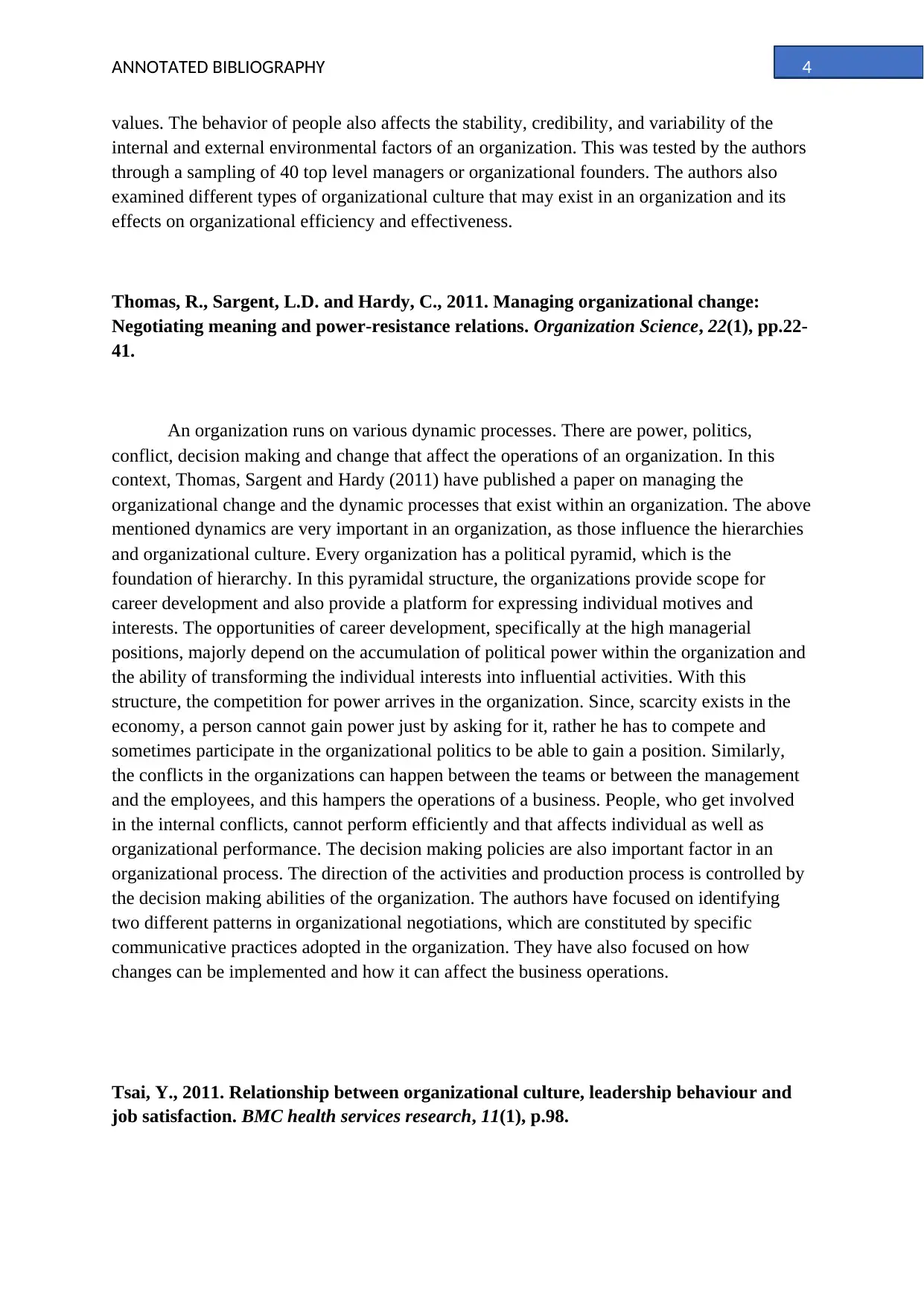
ANNOTATED BIBLIOGRAPHY
values. The behavior of people also affects the stability, credibility, and variability of the
internal and external environmental factors of an organization. This was tested by the authors
through a sampling of 40 top level managers or organizational founders. The authors also
examined different types of organizational culture that may exist in an organization and its
effects on organizational efficiency and effectiveness.
Thomas, R., Sargent, L.D. and Hardy, C., 2011. Managing organizational change:
Negotiating meaning and power-resistance relations. Organization Science, 22(1), pp.22-
41.
An organization runs on various dynamic processes. There are power, politics,
conflict, decision making and change that affect the operations of an organization. In this
context, Thomas, Sargent and Hardy (2011) have published a paper on managing the
organizational change and the dynamic processes that exist within an organization. The above
mentioned dynamics are very important in an organization, as those influence the hierarchies
and organizational culture. Every organization has a political pyramid, which is the
foundation of hierarchy. In this pyramidal structure, the organizations provide scope for
career development and also provide a platform for expressing individual motives and
interests. The opportunities of career development, specifically at the high managerial
positions, majorly depend on the accumulation of political power within the organization and
the ability of transforming the individual interests into influential activities. With this
structure, the competition for power arrives in the organization. Since, scarcity exists in the
economy, a person cannot gain power just by asking for it, rather he has to compete and
sometimes participate in the organizational politics to be able to gain a position. Similarly,
the conflicts in the organizations can happen between the teams or between the management
and the employees, and this hampers the operations of a business. People, who get involved
in the internal conflicts, cannot perform efficiently and that affects individual as well as
organizational performance. The decision making policies are also important factor in an
organizational process. The direction of the activities and production process is controlled by
the decision making abilities of the organization. The authors have focused on identifying
two different patterns in organizational negotiations, which are constituted by specific
communicative practices adopted in the organization. They have also focused on how
changes can be implemented and how it can affect the business operations.
Tsai, Y., 2011. Relationship between organizational culture, leadership behaviour and
job satisfaction. BMC health services research, 11(1), p.98.
4
values. The behavior of people also affects the stability, credibility, and variability of the
internal and external environmental factors of an organization. This was tested by the authors
through a sampling of 40 top level managers or organizational founders. The authors also
examined different types of organizational culture that may exist in an organization and its
effects on organizational efficiency and effectiveness.
Thomas, R., Sargent, L.D. and Hardy, C., 2011. Managing organizational change:
Negotiating meaning and power-resistance relations. Organization Science, 22(1), pp.22-
41.
An organization runs on various dynamic processes. There are power, politics,
conflict, decision making and change that affect the operations of an organization. In this
context, Thomas, Sargent and Hardy (2011) have published a paper on managing the
organizational change and the dynamic processes that exist within an organization. The above
mentioned dynamics are very important in an organization, as those influence the hierarchies
and organizational culture. Every organization has a political pyramid, which is the
foundation of hierarchy. In this pyramidal structure, the organizations provide scope for
career development and also provide a platform for expressing individual motives and
interests. The opportunities of career development, specifically at the high managerial
positions, majorly depend on the accumulation of political power within the organization and
the ability of transforming the individual interests into influential activities. With this
structure, the competition for power arrives in the organization. Since, scarcity exists in the
economy, a person cannot gain power just by asking for it, rather he has to compete and
sometimes participate in the organizational politics to be able to gain a position. Similarly,
the conflicts in the organizations can happen between the teams or between the management
and the employees, and this hampers the operations of a business. People, who get involved
in the internal conflicts, cannot perform efficiently and that affects individual as well as
organizational performance. The decision making policies are also important factor in an
organizational process. The direction of the activities and production process is controlled by
the decision making abilities of the organization. The authors have focused on identifying
two different patterns in organizational negotiations, which are constituted by specific
communicative practices adopted in the organization. They have also focused on how
changes can be implemented and how it can affect the business operations.
Tsai, Y., 2011. Relationship between organizational culture, leadership behaviour and
job satisfaction. BMC health services research, 11(1), p.98.
4
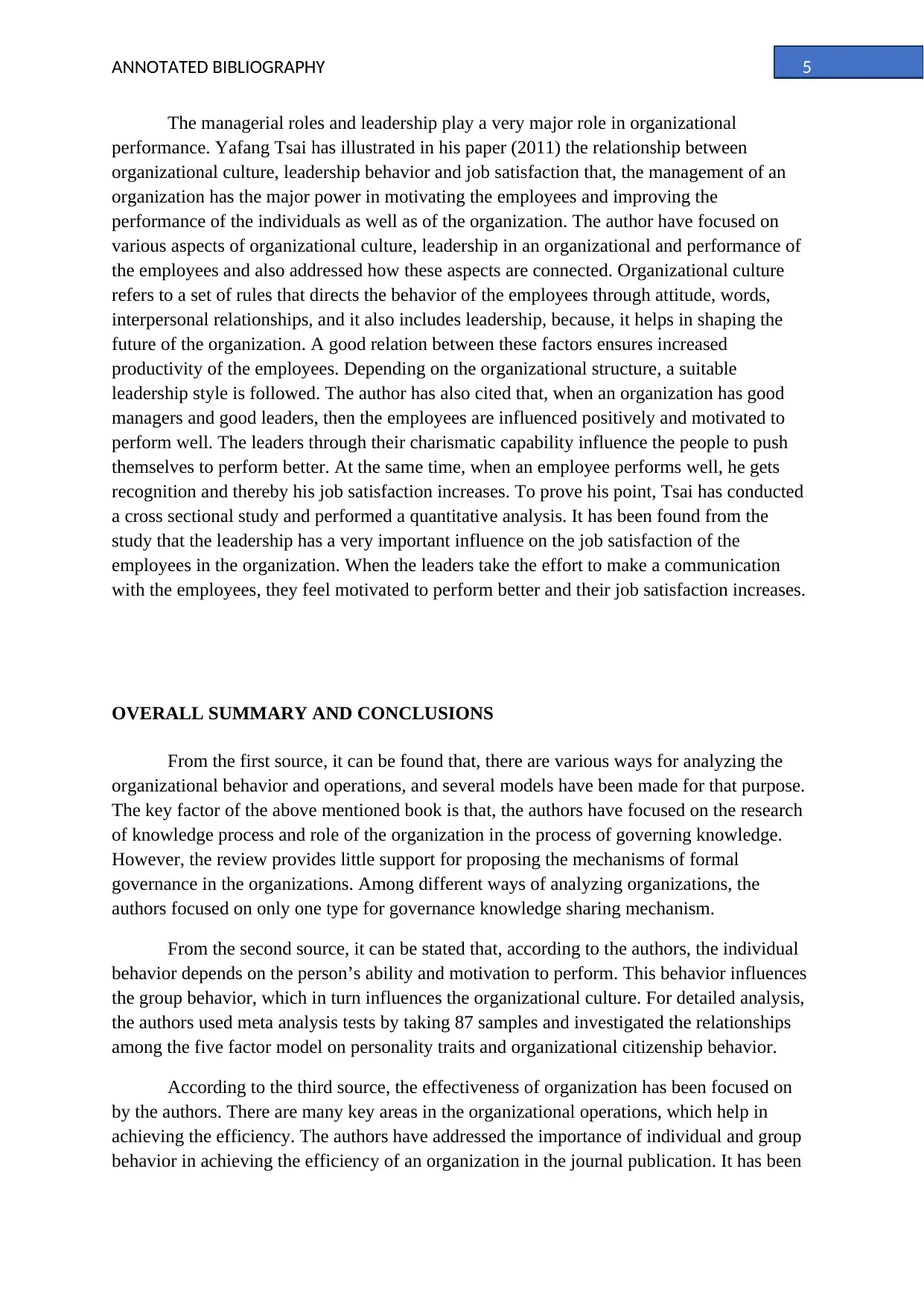
ANNOTATED BIBLIOGRAPHY
The managerial roles and leadership play a very major role in organizational
performance. Yafang Tsai has illustrated in his paper (2011) the relationship between
organizational culture, leadership behavior and job satisfaction that, the management of an
organization has the major power in motivating the employees and improving the
performance of the individuals as well as of the organization. The author have focused on
various aspects of organizational culture, leadership in an organizational and performance of
the employees and also addressed how these aspects are connected. Organizational culture
refers to a set of rules that directs the behavior of the employees through attitude, words,
interpersonal relationships, and it also includes leadership, because, it helps in shaping the
future of the organization. A good relation between these factors ensures increased
productivity of the employees. Depending on the organizational structure, a suitable
leadership style is followed. The author has also cited that, when an organization has good
managers and good leaders, then the employees are influenced positively and motivated to
perform well. The leaders through their charismatic capability influence the people to push
themselves to perform better. At the same time, when an employee performs well, he gets
recognition and thereby his job satisfaction increases. To prove his point, Tsai has conducted
a cross sectional study and performed a quantitative analysis. It has been found from the
study that the leadership has a very important influence on the job satisfaction of the
employees in the organization. When the leaders take the effort to make a communication
with the employees, they feel motivated to perform better and their job satisfaction increases.
OVERALL SUMMARY AND CONCLUSIONS
From the first source, it can be found that, there are various ways for analyzing the
organizational behavior and operations, and several models have been made for that purpose.
The key factor of the above mentioned book is that, the authors have focused on the research
of knowledge process and role of the organization in the process of governing knowledge.
However, the review provides little support for proposing the mechanisms of formal
governance in the organizations. Among different ways of analyzing organizations, the
authors focused on only one type for governance knowledge sharing mechanism.
From the second source, it can be stated that, according to the authors, the individual
behavior depends on the person’s ability and motivation to perform. This behavior influences
the group behavior, which in turn influences the organizational culture. For detailed analysis,
the authors used meta analysis tests by taking 87 samples and investigated the relationships
among the five factor model on personality traits and organizational citizenship behavior.
According to the third source, the effectiveness of organization has been focused on
by the authors. There are many key areas in the organizational operations, which help in
achieving the efficiency. The authors have addressed the importance of individual and group
behavior in achieving the efficiency of an organization in the journal publication. It has been
5
The managerial roles and leadership play a very major role in organizational
performance. Yafang Tsai has illustrated in his paper (2011) the relationship between
organizational culture, leadership behavior and job satisfaction that, the management of an
organization has the major power in motivating the employees and improving the
performance of the individuals as well as of the organization. The author have focused on
various aspects of organizational culture, leadership in an organizational and performance of
the employees and also addressed how these aspects are connected. Organizational culture
refers to a set of rules that directs the behavior of the employees through attitude, words,
interpersonal relationships, and it also includes leadership, because, it helps in shaping the
future of the organization. A good relation between these factors ensures increased
productivity of the employees. Depending on the organizational structure, a suitable
leadership style is followed. The author has also cited that, when an organization has good
managers and good leaders, then the employees are influenced positively and motivated to
perform well. The leaders through their charismatic capability influence the people to push
themselves to perform better. At the same time, when an employee performs well, he gets
recognition and thereby his job satisfaction increases. To prove his point, Tsai has conducted
a cross sectional study and performed a quantitative analysis. It has been found from the
study that the leadership has a very important influence on the job satisfaction of the
employees in the organization. When the leaders take the effort to make a communication
with the employees, they feel motivated to perform better and their job satisfaction increases.
OVERALL SUMMARY AND CONCLUSIONS
From the first source, it can be found that, there are various ways for analyzing the
organizational behavior and operations, and several models have been made for that purpose.
The key factor of the above mentioned book is that, the authors have focused on the research
of knowledge process and role of the organization in the process of governing knowledge.
However, the review provides little support for proposing the mechanisms of formal
governance in the organizations. Among different ways of analyzing organizations, the
authors focused on only one type for governance knowledge sharing mechanism.
From the second source, it can be stated that, according to the authors, the individual
behavior depends on the person’s ability and motivation to perform. This behavior influences
the group behavior, which in turn influences the organizational culture. For detailed analysis,
the authors used meta analysis tests by taking 87 samples and investigated the relationships
among the five factor model on personality traits and organizational citizenship behavior.
According to the third source, the effectiveness of organization has been focused on
by the authors. There are many key areas in the organizational operations, which help in
achieving the efficiency. The authors have addressed the importance of individual and group
behavior in achieving the efficiency of an organization in the journal publication. It has been
5
⊘ This is a preview!⊘
Do you want full access?
Subscribe today to unlock all pages.

Trusted by 1+ million students worldwide
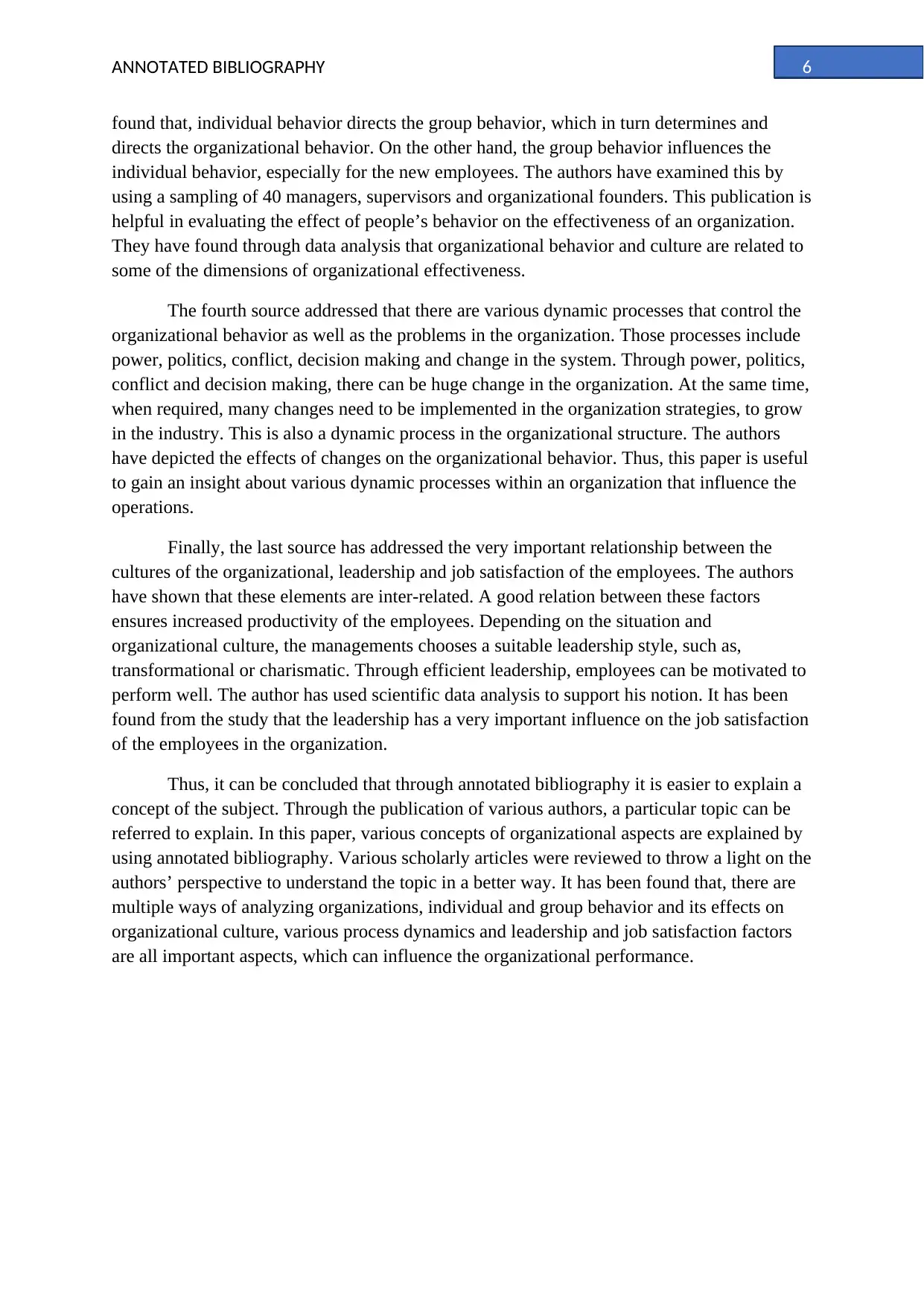
ANNOTATED BIBLIOGRAPHY
found that, individual behavior directs the group behavior, which in turn determines and
directs the organizational behavior. On the other hand, the group behavior influences the
individual behavior, especially for the new employees. The authors have examined this by
using a sampling of 40 managers, supervisors and organizational founders. This publication is
helpful in evaluating the effect of people’s behavior on the effectiveness of an organization.
They have found through data analysis that organizational behavior and culture are related to
some of the dimensions of organizational effectiveness.
The fourth source addressed that there are various dynamic processes that control the
organizational behavior as well as the problems in the organization. Those processes include
power, politics, conflict, decision making and change in the system. Through power, politics,
conflict and decision making, there can be huge change in the organization. At the same time,
when required, many changes need to be implemented in the organization strategies, to grow
in the industry. This is also a dynamic process in the organizational structure. The authors
have depicted the effects of changes on the organizational behavior. Thus, this paper is useful
to gain an insight about various dynamic processes within an organization that influence the
operations.
Finally, the last source has addressed the very important relationship between the
cultures of the organizational, leadership and job satisfaction of the employees. The authors
have shown that these elements are inter-related. A good relation between these factors
ensures increased productivity of the employees. Depending on the situation and
organizational culture, the managements chooses a suitable leadership style, such as,
transformational or charismatic. Through efficient leadership, employees can be motivated to
perform well. The author has used scientific data analysis to support his notion. It has been
found from the study that the leadership has a very important influence on the job satisfaction
of the employees in the organization.
Thus, it can be concluded that through annotated bibliography it is easier to explain a
concept of the subject. Through the publication of various authors, a particular topic can be
referred to explain. In this paper, various concepts of organizational aspects are explained by
using annotated bibliography. Various scholarly articles were reviewed to throw a light on the
authors’ perspective to understand the topic in a better way. It has been found that, there are
multiple ways of analyzing organizations, individual and group behavior and its effects on
organizational culture, various process dynamics and leadership and job satisfaction factors
are all important aspects, which can influence the organizational performance.
6
found that, individual behavior directs the group behavior, which in turn determines and
directs the organizational behavior. On the other hand, the group behavior influences the
individual behavior, especially for the new employees. The authors have examined this by
using a sampling of 40 managers, supervisors and organizational founders. This publication is
helpful in evaluating the effect of people’s behavior on the effectiveness of an organization.
They have found through data analysis that organizational behavior and culture are related to
some of the dimensions of organizational effectiveness.
The fourth source addressed that there are various dynamic processes that control the
organizational behavior as well as the problems in the organization. Those processes include
power, politics, conflict, decision making and change in the system. Through power, politics,
conflict and decision making, there can be huge change in the organization. At the same time,
when required, many changes need to be implemented in the organization strategies, to grow
in the industry. This is also a dynamic process in the organizational structure. The authors
have depicted the effects of changes on the organizational behavior. Thus, this paper is useful
to gain an insight about various dynamic processes within an organization that influence the
operations.
Finally, the last source has addressed the very important relationship between the
cultures of the organizational, leadership and job satisfaction of the employees. The authors
have shown that these elements are inter-related. A good relation between these factors
ensures increased productivity of the employees. Depending on the situation and
organizational culture, the managements chooses a suitable leadership style, such as,
transformational or charismatic. Through efficient leadership, employees can be motivated to
perform well. The author has used scientific data analysis to support his notion. It has been
found from the study that the leadership has a very important influence on the job satisfaction
of the employees in the organization.
Thus, it can be concluded that through annotated bibliography it is easier to explain a
concept of the subject. Through the publication of various authors, a particular topic can be
referred to explain. In this paper, various concepts of organizational aspects are explained by
using annotated bibliography. Various scholarly articles were reviewed to throw a light on the
authors’ perspective to understand the topic in a better way. It has been found that, there are
multiple ways of analyzing organizations, individual and group behavior and its effects on
organizational culture, various process dynamics and leadership and job satisfaction factors
are all important aspects, which can influence the organizational performance.
6
Paraphrase This Document
Need a fresh take? Get an instant paraphrase of this document with our AI Paraphraser
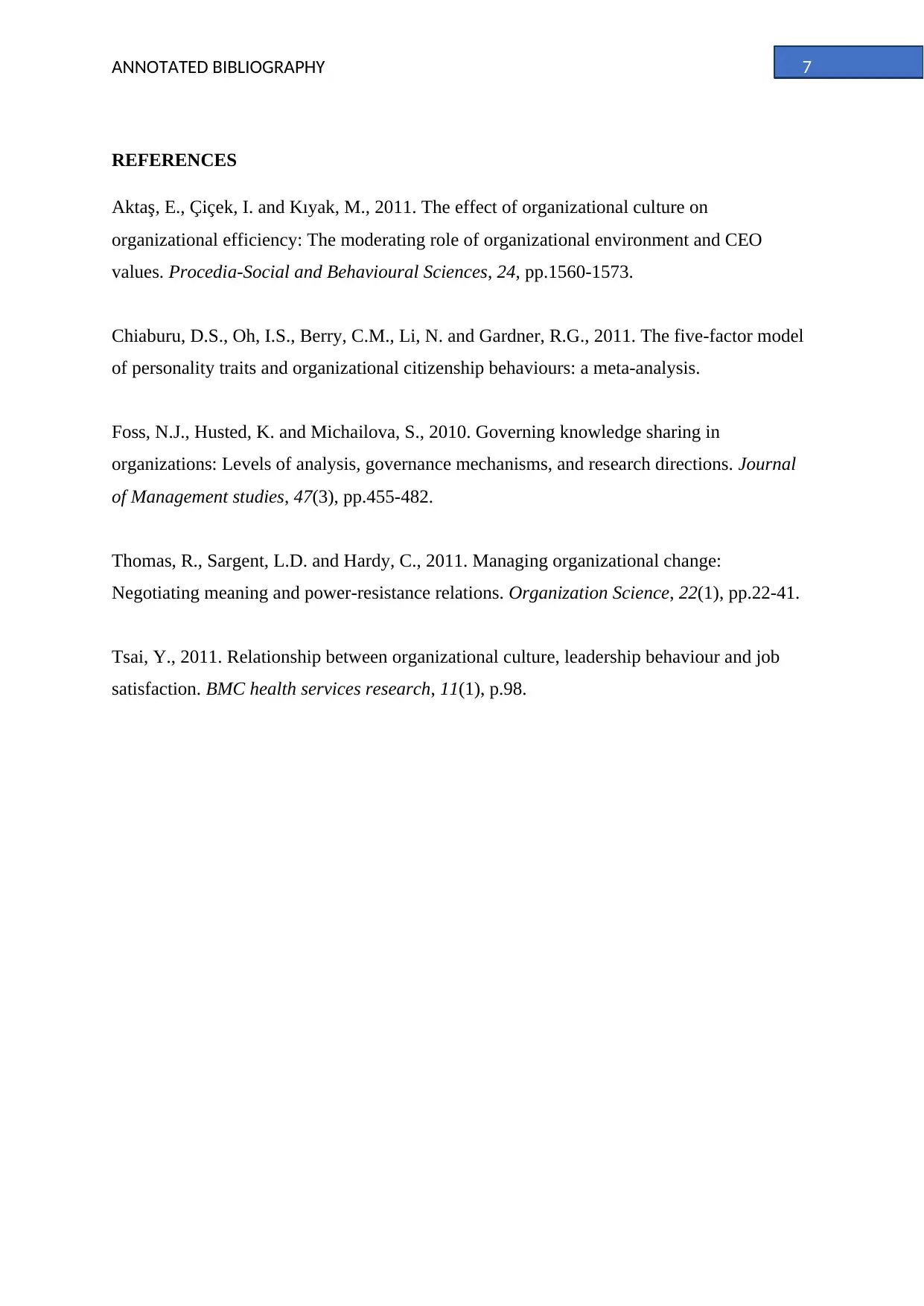
ANNOTATED BIBLIOGRAPHY
REFERENCES
Aktaş, E., Çiçek, I. and Kıyak, M., 2011. The effect of organizational culture on
organizational efficiency: The moderating role of organizational environment and CEO
values. Procedia-Social and Behavioural Sciences, 24, pp.1560-1573.
Chiaburu, D.S., Oh, I.S., Berry, C.M., Li, N. and Gardner, R.G., 2011. The five-factor model
of personality traits and organizational citizenship behaviours: a meta-analysis.
Foss, N.J., Husted, K. and Michailova, S., 2010. Governing knowledge sharing in
organizations: Levels of analysis, governance mechanisms, and research directions. Journal
of Management studies, 47(3), pp.455-482.
Thomas, R., Sargent, L.D. and Hardy, C., 2011. Managing organizational change:
Negotiating meaning and power-resistance relations. Organization Science, 22(1), pp.22-41.
Tsai, Y., 2011. Relationship between organizational culture, leadership behaviour and job
satisfaction. BMC health services research, 11(1), p.98.
7
REFERENCES
Aktaş, E., Çiçek, I. and Kıyak, M., 2011. The effect of organizational culture on
organizational efficiency: The moderating role of organizational environment and CEO
values. Procedia-Social and Behavioural Sciences, 24, pp.1560-1573.
Chiaburu, D.S., Oh, I.S., Berry, C.M., Li, N. and Gardner, R.G., 2011. The five-factor model
of personality traits and organizational citizenship behaviours: a meta-analysis.
Foss, N.J., Husted, K. and Michailova, S., 2010. Governing knowledge sharing in
organizations: Levels of analysis, governance mechanisms, and research directions. Journal
of Management studies, 47(3), pp.455-482.
Thomas, R., Sargent, L.D. and Hardy, C., 2011. Managing organizational change:
Negotiating meaning and power-resistance relations. Organization Science, 22(1), pp.22-41.
Tsai, Y., 2011. Relationship between organizational culture, leadership behaviour and job
satisfaction. BMC health services research, 11(1), p.98.
7
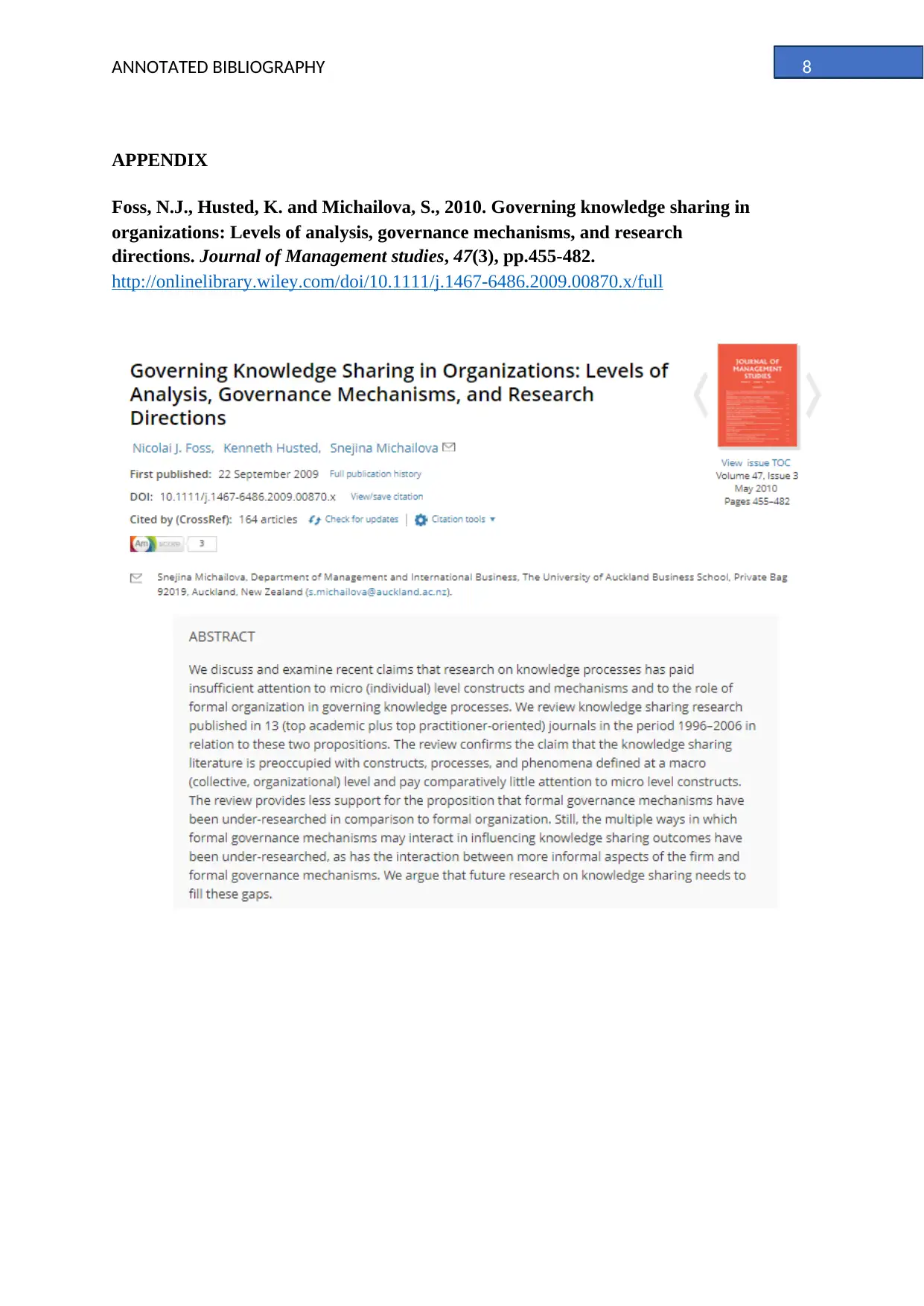
ANNOTATED BIBLIOGRAPHY
APPENDIX
Foss, N.J., Husted, K. and Michailova, S., 2010. Governing knowledge sharing in
organizations: Levels of analysis, governance mechanisms, and research
directions. Journal of Management studies, 47(3), pp.455-482.
http://onlinelibrary.wiley.com/doi/10.1111/j.1467-6486.2009.00870.x/full
8
APPENDIX
Foss, N.J., Husted, K. and Michailova, S., 2010. Governing knowledge sharing in
organizations: Levels of analysis, governance mechanisms, and research
directions. Journal of Management studies, 47(3), pp.455-482.
http://onlinelibrary.wiley.com/doi/10.1111/j.1467-6486.2009.00870.x/full
8
⊘ This is a preview!⊘
Do you want full access?
Subscribe today to unlock all pages.

Trusted by 1+ million students worldwide
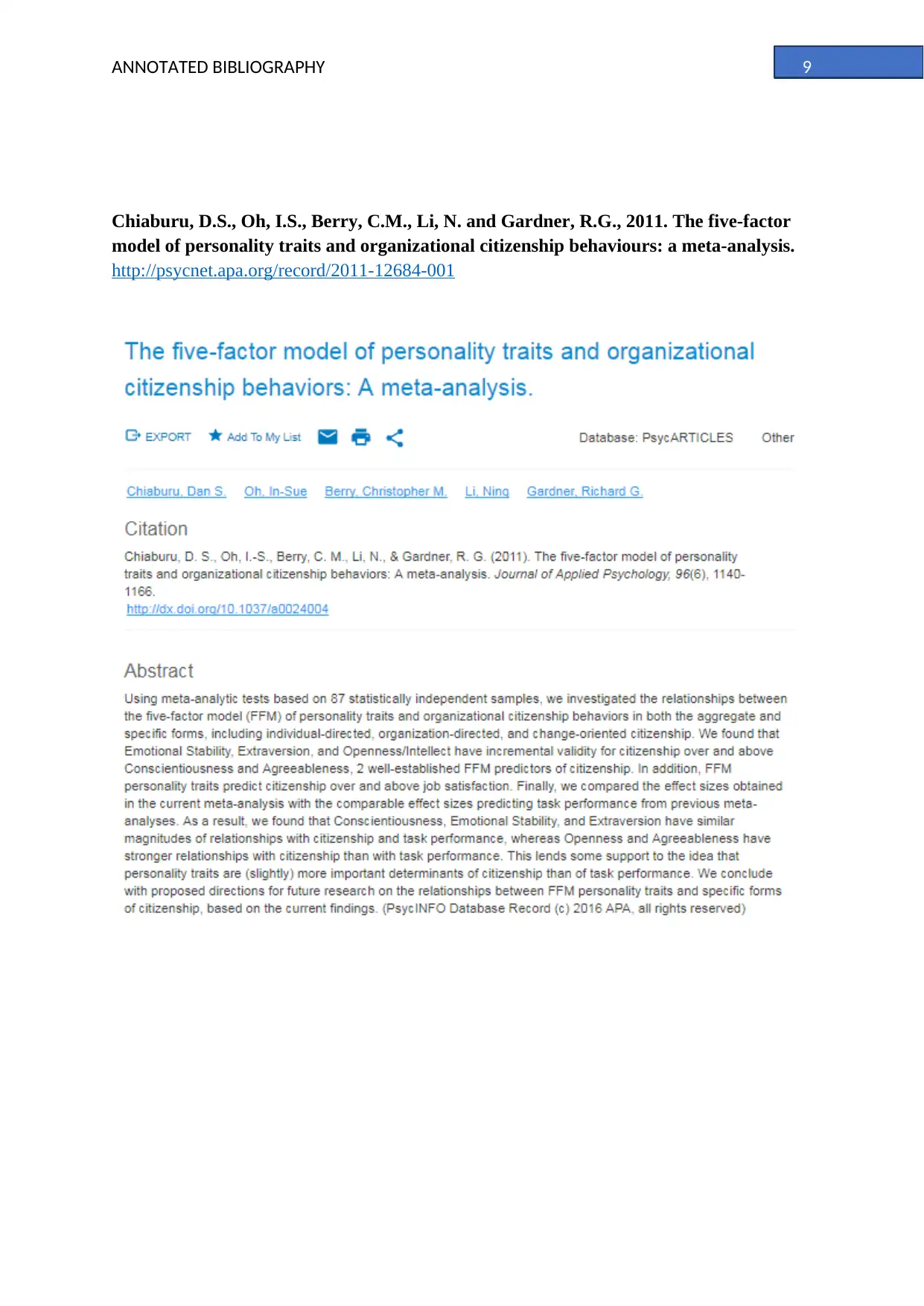
ANNOTATED BIBLIOGRAPHY
Chiaburu, D.S., Oh, I.S., Berry, C.M., Li, N. and Gardner, R.G., 2011. The five-factor
model of personality traits and organizational citizenship behaviours: a meta-analysis.
http://psycnet.apa.org/record/2011-12684-001
9
Chiaburu, D.S., Oh, I.S., Berry, C.M., Li, N. and Gardner, R.G., 2011. The five-factor
model of personality traits and organizational citizenship behaviours: a meta-analysis.
http://psycnet.apa.org/record/2011-12684-001
9
Paraphrase This Document
Need a fresh take? Get an instant paraphrase of this document with our AI Paraphraser
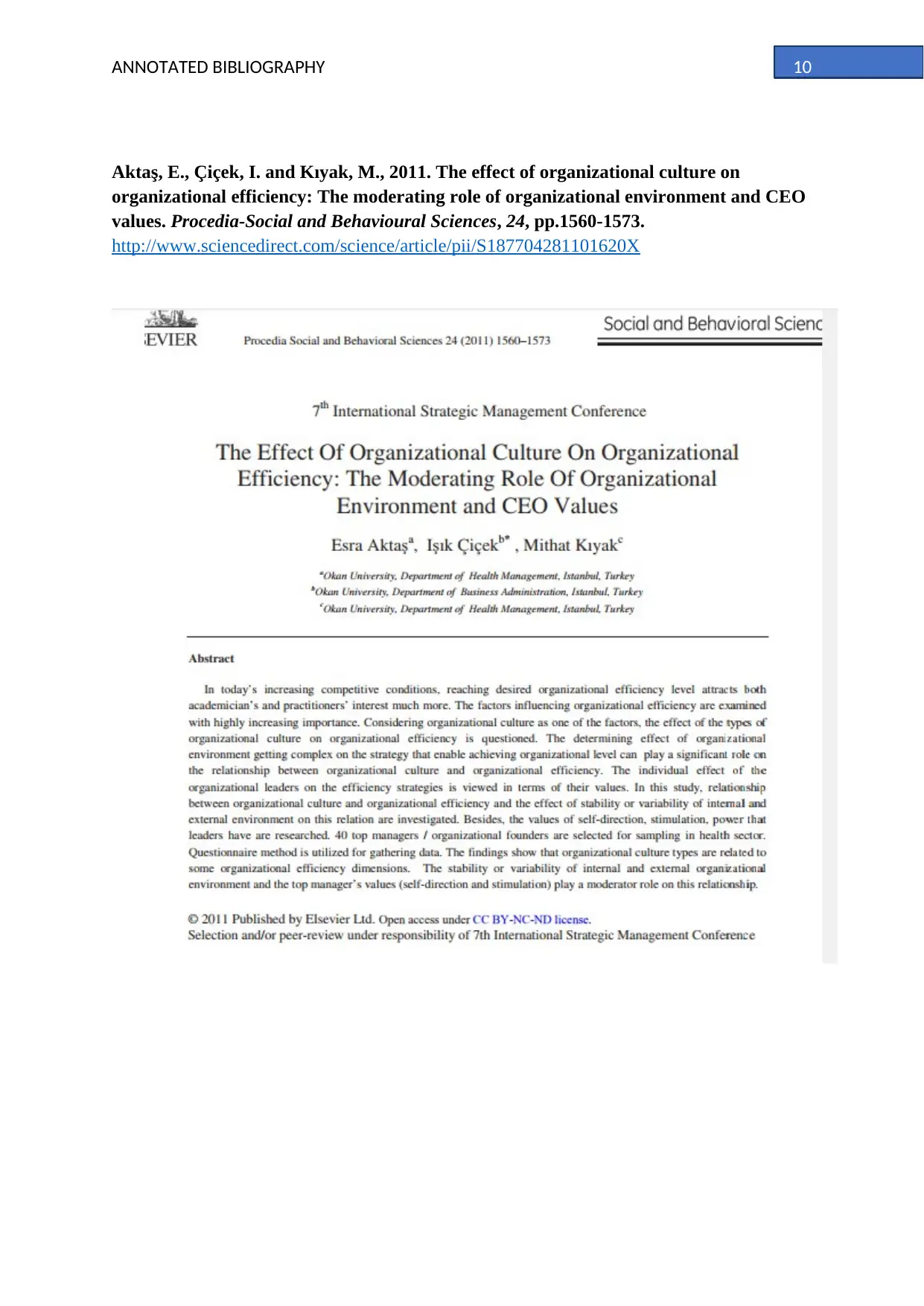
ANNOTATED BIBLIOGRAPHY
Aktaş, E., Çiçek, I. and Kıyak, M., 2011. The effect of organizational culture on
organizational efficiency: The moderating role of organizational environment and CEO
values. Procedia-Social and Behavioural Sciences, 24, pp.1560-1573.
http://www.sciencedirect.com/science/article/pii/S187704281101620X
10
Aktaş, E., Çiçek, I. and Kıyak, M., 2011. The effect of organizational culture on
organizational efficiency: The moderating role of organizational environment and CEO
values. Procedia-Social and Behavioural Sciences, 24, pp.1560-1573.
http://www.sciencedirect.com/science/article/pii/S187704281101620X
10
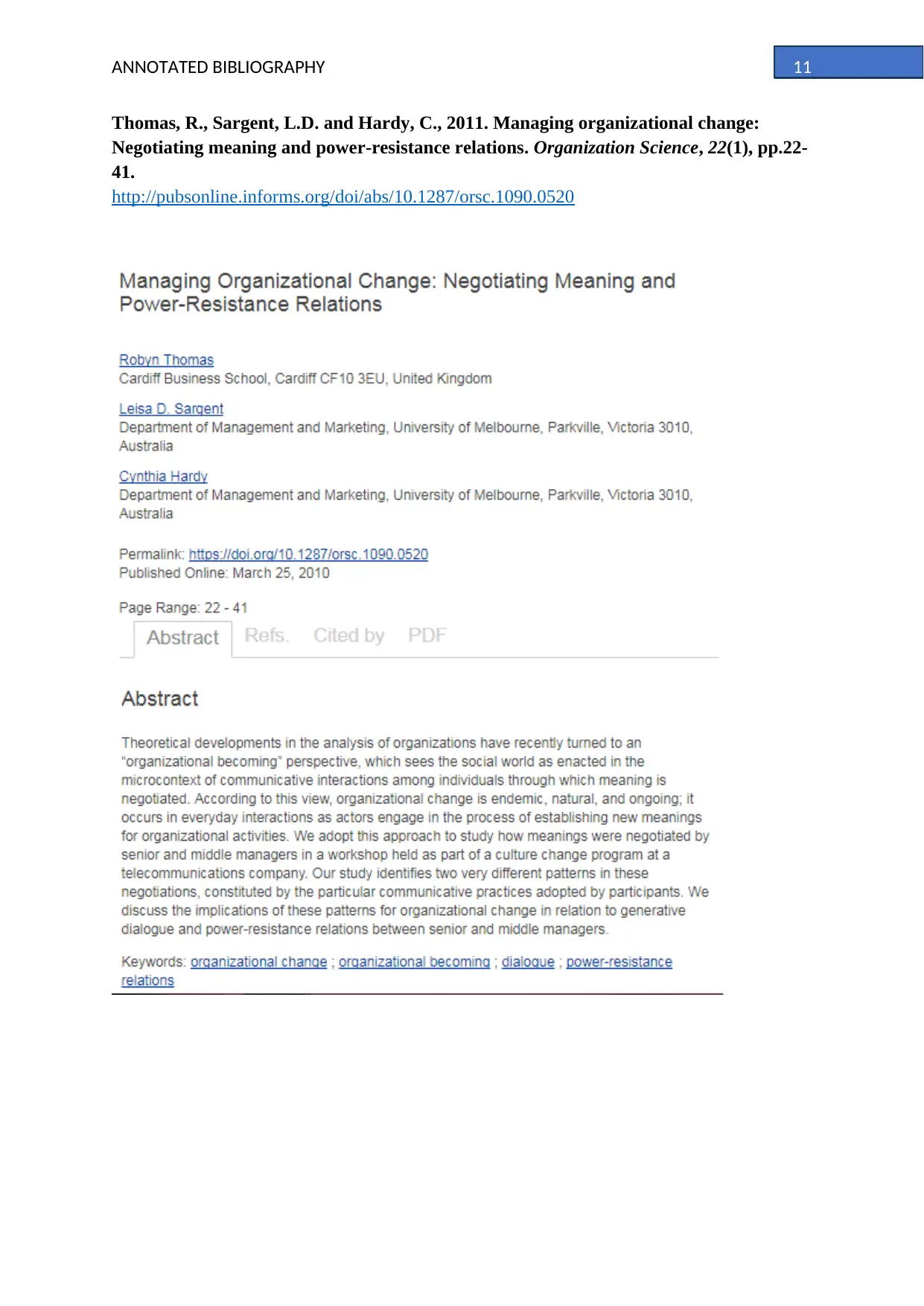
ANNOTATED BIBLIOGRAPHY
Thomas, R., Sargent, L.D. and Hardy, C., 2011. Managing organizational change:
Negotiating meaning and power-resistance relations. Organization Science, 22(1), pp.22-
41.
http://pubsonline.informs.org/doi/abs/10.1287/orsc.1090.0520
11
Thomas, R., Sargent, L.D. and Hardy, C., 2011. Managing organizational change:
Negotiating meaning and power-resistance relations. Organization Science, 22(1), pp.22-
41.
http://pubsonline.informs.org/doi/abs/10.1287/orsc.1090.0520
11
⊘ This is a preview!⊘
Do you want full access?
Subscribe today to unlock all pages.

Trusted by 1+ million students worldwide
1 out of 13
Related Documents
Your All-in-One AI-Powered Toolkit for Academic Success.
+13062052269
info@desklib.com
Available 24*7 on WhatsApp / Email
![[object Object]](/_next/static/media/star-bottom.7253800d.svg)
Unlock your academic potential
Copyright © 2020–2025 A2Z Services. All Rights Reserved. Developed and managed by ZUCOL.


